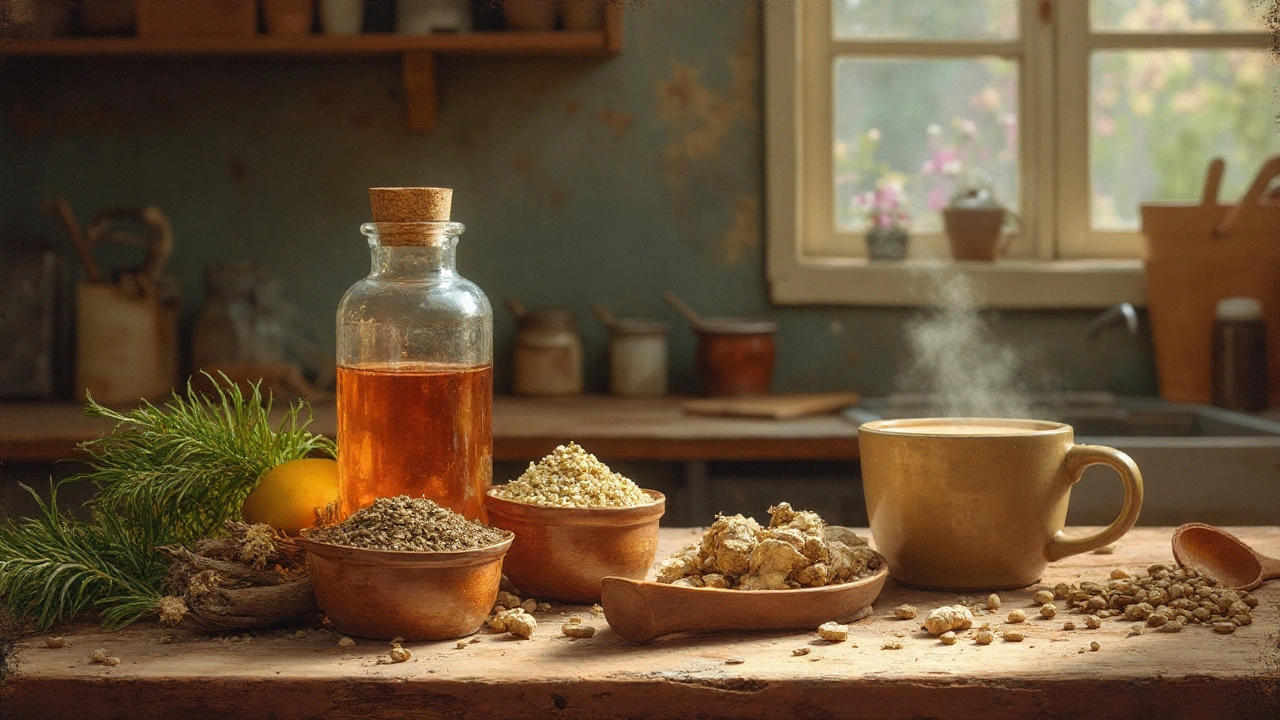White Cohosh is a perennial herb native to eastern North America, scientifically named Actaea racemosa that has been prized for centuries as a natural aid for menopause symptoms. Modern users treat it like a dietary supplement because it offers a plant‑based way to balance hormones without prescription drugs. This guide walks you through the herb’s history, how to pick a quality product, proper dosing, safety flags, and where it stands next to other popular botanicals.
What Is White Cohosh?
The root of White Cohosh contains a mix of triterpene glycosides (like actein) and phytoestrogens. These compounds can gently mimic estrogen activity, which explains why the herb has been used to ease hot flashes, night sweats, and mood swings. Unlike synthetic hormone therapy, the plant’s effect is modest and typically well tolerated when taken at recommended levels.
Traditional Uses and Modern Research
Indigenous peoples of the Great Lakes region brewed white cohosh roots into decoctions for menstrual cramps and childbirth support. In the 20th‑century European herbal pharmacopeia, the plant migrated into "menopause” clinics, where early observational studies reported relief for up to 60% of users.
Recent randomized trials (published in journals such as *Menopause* and *Journal of Herbal Medicine*) have mixed results: some show statistically significant reductions in hot‑flash frequency, while others find no difference from placebo. Meta‑analyses suggest a modest benefit-roughly a 30% drop in symptom severity-when the extract is standardized to contain at least 2% actein.
Regulatory bodies, including the U.S. Food and Drug Administration, classify white cohosh as a dietary supplement, meaning manufacturers must ensure purity but are not required to prove efficacy before market. That’s why quality checks become crucial for consumers.
How to Choose a Quality White Cohosh Supplement
- Standardization: Look for labels that specify a minimum actein content (usually 2%-5%). This guarantees you’re getting the active portion of the root.
- Third‑party testing: Certifications from NSF, USP, or ConsumerLab signal that the product has been screened for heavy metals, pesticides, and adulterants.
- Form: Capsules, tablets, and tinctures are common. Capsules are convenient; tinctures allow flexible dosing and may absorb faster.
- Source transparency: Reputable brands disclose whether the herb is wild‑crafted or cultivated, and they often list the harvest region (e.g., Wisconsin, USA).
Price alone is a poor indicator of quality. A 60‑capsule bottle ranging from $15 to $40 can both meet the same standard; the difference usually lies in packaging and marketing overhead.

Dosage, Safety, and Potential Interactions
Typical adult dosing ranges from 40mg to 80mg of standardized extract daily, split into two doses. Start low (e.g., 20mg) for the first week to assess tolerance.
Common side effects are mild: stomach upset, headache, or a temporary increase in blood pressure. Rarely, users report liver enzyme elevation-most cases resolve after discontinuation.
Because white cohosh can influence estrogen pathways, avoid it if you’re pregnant, nursing, or have a hormone‑sensitive condition (e.g., estrogen‑positive breast cancer). Also, keep it away from blood‑thinning medications (warfarin, clopidogrel) and certain antidepressants (SSRIs), as there are anecdotal reports of increased bleeding risk.
Always discuss supplement use with a healthcare provider, especially if you’re on prescription drugs. A quick check with your pharmacist can prevent unwanted interactions.
Comparing White Cohosh with Similar Herbs
| Herb | Scientific Name | Primary Active Compounds | Typical Use | Standardized Dosage |
|---|---|---|---|---|
| White Cohosh | Actaea racemosa | Actein, triterpene glycosides | Menopausal hot flashes, mood swings | 40‑80mg extract (2% actein) |
| Black Cohosh | Actaea cimicifuga | Cimicifugosides, flavonoids | Hormonal balance, menstrual cramps | 20‑40mg extract (2.5% cimicifugosides) |
| Red Clover | Trifolium pratense | Isoflavones (genistein, daidzein) | Bone health, mild estrogen support | 40‑80mg extract (20% isoflavones) |
All three herbs belong to the broader class of phytoestrogen‑rich botanicals, but their chemical profiles differ. White Cohosh leans heavily on triterpene glycosides, which appear to act on the central nervous system, whereas Red Clover’s isoflavones bind directly to estrogen receptors. Black Cohosh shares a genus with White Cohosh but contains a distinct set of saponins, making its safety profile slightly different.
Related Concepts and Next Steps
Understanding white cohosh doesn’t happen in isolation. It intersects with several wider topics you might want to explore:
- Hormonal Balance - the broader physiological goal behind many herbal interventions.
- Menopause Management - lifestyle, diet, and exercise strategies that complement botanical supplements.
- Dietary Supplement Regulation - how agencies like the FDA and EFSA oversee quality, labeling, and safety claims.
- Synergistic blends - combining white cohosh with Black Cohosh or Red Clover for a broader symptom profile (always under professional guidance).
If you’re ready to try white cohosh, start by picking a reputable, third‑party‑tested product, follow the low‑and‑slow dosing rule, and track your symptoms in a journal. After a few weeks, you’ll have concrete data to decide if the herb is working for you.

Frequently Asked Questions
Is white cohosh safe for long‑term use?
Most studies cover 12‑month periods and show a good safety profile when the extract is standardized to ≤5% actein. However, routine liver‑function checks are advised after six months, especially for people with pre‑existing liver conditions.
Can I take white cohosh with prescription hormone therapy?
Combining the two can increase estrogenic activity and may raise the risk of side effects like blood clots. Talk to your doctor before stacking them.
How does white cohosh compare to synthetic estrogen pills?
Synthetic estrogens provide a stronger, more predictable hormone boost, which can be essential for severe symptoms. White cohosh offers a milder, plant‑based effect that may suffice for mild to moderate hot flashes with fewer cardiovascular risks.
What should I look for on a supplement label?
Key items are the botanical name (Actaea racemosa), a standardized actein percentage (≥2%), the amount of extract per serving, and a third‑party certification seal.
Can men and women both benefit from white cohosh?
While most research targets menopausal women, men sometimes use white cohosh for joint discomfort or to mitigate stress‑related hormonal swings. Evidence is limited, so start with a low dose and monitor effects.


Man, I tried white cohosh last year after my mom swore by it for her hot flashes. Took it for 3 weeks, felt like my brain was stuck in slow motion. Headaches, weird dizziness - I quit. Not worth it for me. But hey, maybe I just got a bad batch?
OMG I’m so obsessed with this herb right now 😍 I’ve been taking the Gaia Herbs standardized extract (5% actein, obviously) and my mood has gone from ‘I hate everyone’ to ‘I’m basically a zen goddess’ 🌸✨ Also, I paired it with magnesium glycinate and holy basil tincture - total trifecta for hormonal harmony. If you’re not optimizing, you’re just surviving 💅
What is this, some hippie nonsense? We’ve got FDA-approved HRT for a reason. This whole ‘natural remedy’ crap is just Big Herbal marketing to gullible people. My cousin took this stuff and ended up in the ER with liver inflammation. Don’t be a lab rat for some startup selling root tea in a mason jar.
YOU GOT THIS! 🙌 If you're even thinking about trying white cohosh, go for it - but start LOW, track your symptoms, and celebrate every small win. Your body is smart - listen to it! I went from 7 hot flashes a day to 1-2 in 4 weeks. It’s not magic, it’s medicine 🌿💪 You’ve got the power to take control!
Just wanted to say I’ve been using this for 11 months now - bought it from a small co-op in Wisconsin that sources wild-harvested roots. My mom’s Ojibwe, and she taught me that this herb was never meant to be boiled down into a capsule. It’s sacred, you know? I take it in tincture form, 15 drops twice a day, and I feel… balanced. Not cured, not perfect - just… steady. Hope you find your own rhythm with it 🙏
The meta-analysis referenced in the article shows a modest effect size of d = 0.38 for hot flash reduction, which is statistically significant but clinically marginal. The heterogeneity across trials (I² = 67%) suggests substantial variability in product quality and participant compliance. Standardization remains the single most critical variable for reproducible outcomes.
While the pharmacological profile of Actaea racemosa demonstrates plausible biological activity via triterpene glycoside modulation of hypothalamic thermoregulatory centers, the absence of long-term, large-scale, double-blind, placebo-controlled trials precludes definitive clinical recommendations. I advise all patients to disclose supplement use to their primary care provider as part of a comprehensive medication reconciliation protocol.
Let’s be real - the whole phytoestrogen narrative is a Western reductionist fantasy. In Ayurveda, we don’t treat ‘hot flashes’ as an isolated symptom. We look at apana vayu imbalance, agni weakness, and srotoavarodha. White cohosh? It’s like throwing a Band-Aid on a ruptured artery. You need triphala to clear ama, ashwagandha to stabilize vata, and shatavari to nourish rasa dhatu. This herb might help a little if your dosha is kapha-pitta dominant and you’re not eating cold pizza at midnight. But if you think a capsule fixes hormonal chaos? Honey, you’re missing the whole forest for one tree. And yes, I’ve seen women in Kerala get relief from this - but only after 6 months of diet, yoga, and sleep hygiene. No supplement is a shortcut. It’s a tool, not a savior.